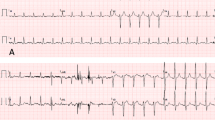Abstract
A 13-year-old female was found lifeless at home. The autopsy and consecutive histological and toxicological examinations showed blood-rich and edematous lungs and foamy bloody content in the airways. No morphologic pathological findings were seen, especially no bleeding sources. Toxicological findings were unremarkable. The specific cause of death remained unclear. Due to reported losses of consciousness, a moleculargenetic postmortem testing was performed. A so far undescribed mutation in the cardiac ryanodine receptor gene RyR2 was detected. This mutation is suitable to explain the case history as well as the morphological findings. The cardiac ryanodine receptor gene RyR2 encodes the ryanodine receptor type 2, an ion channel in the cardiomyocytes. The ion channel regulates the influx of calcium ions and thus influences myocardial activity. Mutations in this channel may result in the catecholaminergic polymorphic ventricular tachycardia (CPVT), a cardiac arrhythmia that can lead to syncope and sudden cardiac death. This case demonstrates the usefulness and need of molecular autopsy, in particular to identify and treat possibly affected family members.

Similar content being viewed by others
References
Kauferstein S, Kiehne N, Neumann T, Pitschner H-F, Bratzke H (2009) Cardiac gene defects can cause sudden cardiac death in young people. Dtsch Ärztebl Int 4:41–47
Kazemian P, Gollob MH, Pantano A, Oudit GY (2011) A novel mutation in the RYR2 gene leading to catecholaminergic polymorphic ventricular tachycardia and paroxysmal atrial fibrillation: dose-dependent arrhythmia-event suppression by b-blocker therapy. Can J Cardiol 27:870.e7–870.e10
Siauw C, Schröder D, Wirbelauer J (2016) Synkope eines Jugendlichen. Monatsschr Kinderheilkd 164:497–499
Cerrone M, Colombi B, Santoro M, di Barletta MR, Scelsi LV, Napolitano C, Priori SG (2005) Bidirectional ventricular tachycardia and fibrillation elicited in a knock-in mouse model carrier of a mutation in the cardiac ryanodine receptor. Circ Res 96:e77–e82
Bauce B, Rampazzo A, Basso C, Bagattin A, Daliento L, Tiso N, Turrini P, Thiene G, Danieli GA, Nava A (2002) Screening for ryanodine receptor type 2 mutations in families with effort-induced polymorphic ventricular arrhythmias and sudden death. J Am Coll Cardiol 40(2):341–349
Li W, Zhang L, Liang Y, Tong F, Zhou Y (2017) Sudden death due to malignant hyperthermia with a mutation of RYR1: autopsy, morphology and genetic analysis. Forensic Sci Med Pathol 13:444–449
Russell T, Riazi S, Kraeva N, Steel AC, Hawryluck LA (2012) Ecstacy-induced delayed rhabdomyolysis and neuroleptic malignant syndrome in a patient with a novel variant in the ryanodine receptor type 1 gene. Anaesthesia 67:1021–1024
Laitinen PJ, Brown KM, Piippo K, Swan H, Devaney JM, Brahmbhatt B, Donarum EA, Marino M, Tiso N, Viitasalo M, Toivonen L, Stephan SA, Kontula K (2001) Mutations of the cardiac ryanodine receptor (RyR2) gene in familial polymorphic ventricular tachycardia. Circulation 103:r7–r12
Kiehne N (2011) Molekulare Grundlagen zur Diagnostik und Ätiologie genetisch bedingter kardiovaskulärer Erkankungen als Auslöser des plötzlichen Herztodes. Dissertation, Technische Universität Darmstadt
Wehrens XHT, Lehnart SE, Huang F, Vest JA, Reiken SR, Mohler PJ, Sun J, Guatimosim S, Song L-S, Rosemblit N, D’Armiento JMD, Napolitano C, Memmi M, Priori SG, Lederer WJ, Marks AR (2003) FKBP12.6 deficiency and defective calcium release channel (ryanodine receptor) function linked to exercise-induced sudden cardiac death. Cell 113:829–840
Deutsche Gesellschaft für Rechtsmedizin (2017) Leitlinie der Deutschen Gesellschaft für Rechtsmedizin: Die rechtsmedizinische Leichenöffnung. https://www.awmf.org/uploads/tx_szleitlinien/054-001l_S1_Die-rechtsmedizinische_Leichenoeffnung_2018-02.pdf. Accessed 27 May 2019
Kircher M, Witten DM, Jain P, O’Roak BJ, Cooper GM, Shendure J (2014) A general framework for estimating the relative pathogenicity of human genetic variants. Nat Genet 46(3):310–315
Larsen MK, Berge KE, Leren TP, Nissen PH, Hansen J, Kristensen IB, Banner J, Jensen HK (2013) Postmortem genetic testing of the ryanodine receptor 2 (RYR2) gene in a cohort of sudden unexplained death cases. Int J Legal Med 127:139–144
Stattin EL, Westin IM, Cederquist K, Jonasson J, Jonsson BA, Mörner S, Norberg A, Krantz P, Wisten A (2016) Genetic screening in sudden cardiac death in the young can save future lives. Int J Legal Med 130:59–66
Neubauer J, Lecca MR, Russo G, Bartsch C, Medeiros-Domingo A, Berger W, Haas C (2018) Exome analysis in 34 sudden unexplained death (SUD) victims mainly identified variants in channelopathy-associated genes. Int J Legal Med 132:1057–1065
Hertz CL, Christiansen SL, Ferrero-Miliani L, Fordyce SL, Dah M, Holst AG, Ottesen GL, Frank-Hansen R, Bundgaard H, Morling N (2015) Next-generation sequencing of 34 genes in sudden unexplained death victims in forensics and in patients with channelopathic cardiac diseases. Int J Legal Med 129:793–800
Campuzano O, Sarquella-Brugada G, Brugada R, Brugada J (2015) Genetics of channelopathies associated with sudden cardiac death. Glob Cardiol Sci Pract 2015:39
Frommeyer G, Pott C, Eckardt L, Schulze-Bahr E (2012) Katecholaminerge polymorphe ventrikuläre Tachykardien. Herzschrittmacherther Elektrophysiol 23:231–223
Brockmeier K, Sreeram N, Khalil M, Udink ten Cate F, Adelmann R (2013) Ionenkanalerkrankungen. Monatsschr Kinderheilkd 161:798–806
Schimpf R, Kuschyk J, Veltmann C, Borggrefe M, Wolpert C (2005) Primary electrical heart disease in adulthood – electrophysiological findings and therapy. Herzschrittmacherther Elektrophysiol 16:250–259
Bezzina CR, Lahrouchi N, Priori SG (2015) Genetics of sudden cardiac death. Circ Res 116:1919–1936
HGMD professional. http://www.hgmd.cf.ac.uk. Accessed 31 January 2018
Schulze-Bahr E, Klaassen S, Abdul-Khaliq H, Schunkert H (2015) Gendiagnostik bei kardiovaskulären Erkrankungen – Positionspapier der Deutschen Gesellschaft für Kardiologie (DGK) und der Deutschen Gesellschaft für Pädiatrische Kardiologie (DGPK). Kardiologe 9:213–243
Author information
Authors and Affiliations
Corresponding author
Ethics declarations
Informed consent was obtained. The case report complies the current German law.
Conflict of interest
The authors declare that they have no conflict of interest.
Additional information
Publisher’s note
Springer Nature remains neutral with regard to jurisdictional claims in published maps and institutional affiliations.
Rights and permissions
About this article
Cite this article
Mahlke, N., Dittmann, S., Schulze-Bahr, E. et al. Sudden unexpected cardiac death and postmortem identification of a novel RYR2 gene mutation. Int J Legal Med 133, 1835–1838 (2019). https://doi.org/10.1007/s00414-019-02117-x
Received:
Accepted:
Published:
Issue Date:
DOI: https://doi.org/10.1007/s00414-019-02117-x




